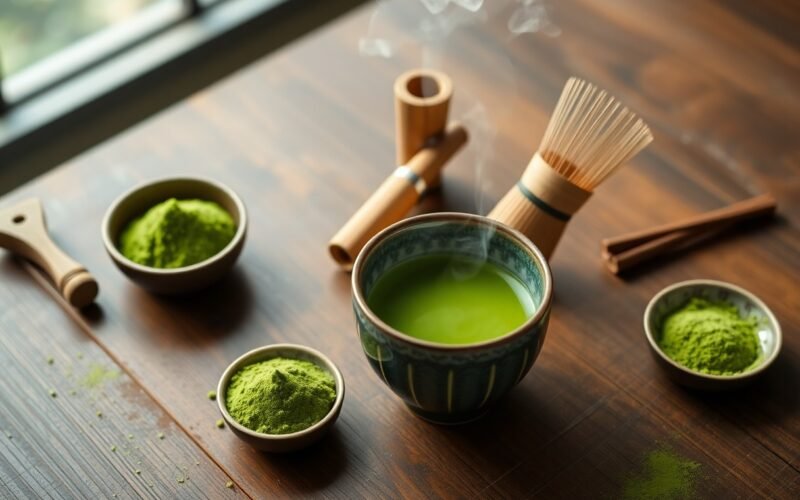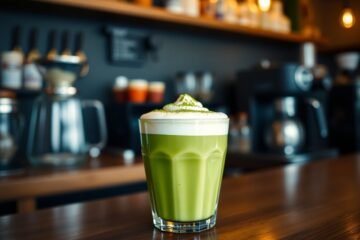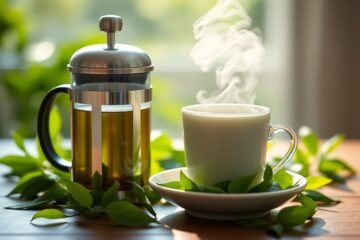Just imagine sipping a frothy, vibrant cup of matcha that energizes your spirit and fuels your day. In this guide, you will learn the vital steps to craft the perfect cup of matcha every time, ensuring a harmonious balance of flavor and texture. From selecting high-quality matcha to mastering the whisking technique, your journey is about to elevate your tea experience. For more insights, check out this How can I make the best cup of matcha, and … to dive deeper into the world of matcha.
Key Takeaways:
- Use high-quality matcha powder for the best flavor and health benefits.
- Optimal water temperature is between 160°F to 175°F to avoid bitterness.
- Whisk vigorously in a ‘W’ motion to achieve a smooth and frothy texture.
Unlocking the Secrets of Quality Matcha
Brewing matcha is not just an art; it’s a science grounded in sourcing and understanding quality. Selecting the right matcha involves recognizing the intricate variables that contribute to its flavor, color, and health benefits. From the growing conditions to the harvesting methods, each aspect plays a pivotal role in ensuring a superior product. Knowing how to differentiate quality matcha can transform your experience from mediocre to extraordinary.
Sourcing the Finest Matcha
To enjoy the full benefits of matcha, you must start with the finest leaves. Authentic, high-quality matcha is often sourced from Japan, particularly regions like Uji, Nishio, and Shizuoka. Look for brands that provide transparency around their sourcing practices and verify that their leaves are shade-grown, hand-picked, and stone-ground to achieve that vibrant green hue and rich umami flavor.
The Importance of Matcha Grades
Matcha comes in various grades, each designed for specific uses. Ceremonial grade is the top-tier option, intended for traditional tea drinking, boasting a delicate taste and vibrant color. Premium grade, while slightly less refined, is still excellent for both drinking and culinary purposes. Culinary grade matcha, which contains a coarser grind and bolder flavor, is typically used in recipes, from baked goods to lattes, allowing versatility in the kitchen.
Understanding matcha grades can significantly enhance your selection process. For instance, ceremonial grade matcha exemplifies exquisite quality, featuring young tea leaves that produce a smooth, rich flavor desirable in tea ceremonies. Conversely, premium and culinary grades, while lower in price, can be perfect for adding matcha into your everyday recipes without sacrificing flavor too much. When dicking out matcha, always check labels mentioning grade, sourcing, and certifications to ensure you’re getting a product that meets your expectations—because great matcha could lead to great experiences.

Precision Tools for Brewing
Having the right tools can significantly elevate your matcha experience. Precision tools help ensure you achieve that perfect blend of flavors and textures every time you brew. Invest in a few important pieces to take your matcha preparation to the next level. From traditional whisks to high-quality bowls, these items will become indispensable in your pursuit of matcha perfection.
Essential Equipment for the Perfect Brew
For an exceptional matcha brew, you’ll need a few key items: a *chawan* (matcha bowl), a *chasen* (bamboo whisk), and a *shakumi* (fine sieve). The *chawan* allows for optimal mixing space, while the *chasen* ensures frothy perfection. A *shakumi* helps eliminate clumps, giving you a smooth blend. Each tool plays a vital role in creating a flawless cup that showcases matcha’s unique taste.
Choosing the Right Water and Temperature
Water quality and temperature are pivotal in unlocking the flavors of matcha. Soft or filtered water is recommended, as hard water can alter the flavor profile. Aim for temperatures between 160°F to 175°F (70°C to 80°C) to prevent bitterness. Overheating can destroy the delicate catechins, the antioxidants that make matcha so beneficial.
| Water Type | Preferably soft or filtered water to reduce impurities. |
| Temperature Range | 160°F to 175°F (70°C to 80°C) for optimal flavor. |
The right temperature not only avoids bitterness but also preserves the vibrant green color of the matcha. Testing your water with a thermometer can ensure consistency, so you can perfect your brewing technique. Using water that’s too cold will lead to a flat taste, while boiling water will scorch the matcha. Adjusting these elements will help you refine the subtleties in flavor, allowing you to create a cup that is both delightful and nourishing.
| Under 160°F | Muted flavors and poor whisking results. |
| 160°F to 175°F | Bright, vibrant flavor profiles with a smooth texture. |
| Over 175°F | Increased bitterness and loss of delicate notes. |
Mastering the Brewing Technique
Achieving the perfect cup of matcha is a delicate balance of technique and timing. Start by using a fine mesh sieve to sift your matcha powder into your bowl, eliminating any clumps. Gradually pour in hot water that’s around 160°F to 175°F (70°C to 80°C), not boiling, to preserve matcha’s nuanced flavors. Then, take your chasen, or bamboo whisk, and whisk in a letter “M” motion. For more detailed instructions, check out Eric Gower’s Perfect Cup of Matcha.
The Steps to Whisking Your Matcha
To whisk your matcha effectively, start with the dry powder, ensuring it’s free of lumps. Add just enough water to create a thick paste before gradually incorporating more water. Using the chasen, whisk swiftly in a zig-zag or “M” motion to aerate the mixture. Aim for a frothy finish with small bubbles on top, which is a sign of a well-executed whisk. The goal is a smooth, creamy consistency that enhances the matcha’s natural sweetness.
Common Mistakes to Avoid
Avoid pouring boiling water directly onto your matcha, as this can lead to a bitter taste and destroy the delicate nutrients. Not whisking vigorously enough can leave clumps in the mixture, detracting from the overall texture. It’s also crucial to use the right matcha-to-water ratio; too much water can dilute the flavors while too little can result in a chalky brew.
Focusing on these common mistakes can significantly improve your matcha game. Do not overlook the importance of water temperature; boiling water not only alters the flavor but can also break down vital antioxidants found in matcha. The ideal ratio is generally 1-2 teaspoons of matcha to 2-4 ounces of hot water, catering to your personal taste preferences. Lastly, always take the time to whisk until frothy; a lack of proper aeration can result in an unsatisfactory cup that lacks the creamy texture associated with a well-prepared matcha. By avoiding these pitfalls, you can enjoy a consistently delightful matcha experience.
Tailoring Your Cup to Perfection
Creating your ideal matcha is a personal journey, and it often requires some fine-tuning to align with your taste preferences. From the subtle sweetness to the depth of umami flavors, you have the freedom to adjust your brew to taste. Experimenting with the amount of matcha powder can bring out different dimensions; a lighter mix can yield a more refreshing drink, while a stronger concentration can create a rich and robust experience. Each adjustment invites you to discover your own matcha signature.
Flavor Adjustments for Personal Preference
Adjusting your matcha can be as simple as tweaking the ratio of matcha powder to water. If you prefer a sweeter profile, add a bit of honey or agave syrup, ensuring you find the balance that pleases your palate. For a creamier texture, consider increasing the milk or using a frother to amp up fluffiness. Gently experimenting with these factors allows you to cultivate a cup that feels uniquely yours.
Enhancing Matcha with Creative Add-ins
Elevate your matcha experience by incorporating various add-ins to enhance flavor and nutrition. Ingredients like vanilla extract, cinnamon, or even a splash of coconut milk introduce enticing layers to your drink. A handful of nuts or seeds can contribute texture and health benefits, while superfoods like spirulina or collagen can give your matcha an extra nutritional punch.
For instance, adding a few drops of vanilla extract not only enhances the flavor but also complements matcha’s earthy notes perfectly. Cinnamon offers a warm spice, while coconut milk can create a tropical flair. You can also experiment with matcha lattes by blending pumpkin puree and spices for a seasonal twist. Furthermore, infusing your matcha with adaptogenic herbs such as ashwagandha can boost its health properties. With creativity, the possibilities are endless, allowing each cup of matcha to be a delightful exploration of flavors and nourishing benefits.
Building a Matcha Ritual
Creating a matcha ritual transforms your brewing process into a moment of self-care and mindfulness. As you learn the art of making matcha, consider How to Make Matcha in 5 Easy Steps | Bird & Blend Tea Co. This small ritual can center your thoughts and help you appreciate the subtle tastes and vibrant colors of matcha. By carving out this dedicated time, you’ll develop a deeper connection to your cups and enjoy each sip even more.
Establishing a Mindful Brewing Process
Mindful brewing involves immersing yourself in the entire experience, from selecting the right matcha to the final sip. Focus on the sounds, scents, and sights during the process. When you whisk the matcha, notice the soft froth forming and the vibrant green hue expanding in your bowl. This intentional attention not only enhances your skills but also integrates mindfulness into your daily life, fostering a peaceful state as you enjoy your drink.
Incorporating Matcha into Your Daily Routine
Integrating matcha into your daily routine can be seamless and rewarding. Consider starting your day with a warm cup of matcha instead of coffee. This switch not only offers a gentle caffeine boost but also provides a wealth of antioxidants. You might also enjoy matcha lattes, smoothies, or even baked goods to satisfy a sweet craving while reaping the benefits of this superfood. Making matcha a consistent part of your day ensures you keep its potential alive in various enjoyable forms.
Summing up
With these considerations in mind, you can easily prepare the perfect cup of matcha every time. Focus on selecting high-quality matcha powder, using the right water temperature, and whisking with care to achieve that desirable frothy texture. Pay attention to your measurements and find the right balance that suits your palate. By following these tips and practicing your technique, you’ll not only enhance your matcha-making skills but also enjoy a delicious and energizing beverage that nourishes your body and mind.
FAQ
Q: What type of matcha should I use for the best flavor?
A: For the best flavor, opt for high-quality ceremonial grade matcha. This type is sourced from younger tea leaves that are shade-grown and carefully processed, resulting in a vibrant green color and rich umami flavor. Look for matcha that is bright green and finely ground; avoid any that appears dull or clumpy, as these may be lower quality or older matcha.
Q: What tools do I need to make matcha properly?
A: To make matcha properly, you’ll need a few crucial tools: a matcha bowl (or chawan), a bamboo whisk (chasen), a bamboo scoop (chashaku) for measuring, and a fine sieve to sift the matcha powder. These tools help create a smooth and frothy cup of matcha. Additionally, using a thermometer to ensure your water is at the right temperature (around 160-175°F or 70-80°C) can help achieve the best flavor without bitterness.
Q: How can I avoid clumps in my matcha when preparing it?
A: To avoid clumps in your matcha, it’s advisable to sift the matcha powder through a fine sieve before adding water. This helps break up any clumps that may have formed. When mixing, use the bamboo whisk to whisk in a circular motion or an ‘M’ shape to fully incorporate the powder into the water. Adding a small amount of hot water first and making a paste, before progressively adding more water, can also help create a smooth consistency without clumps.




